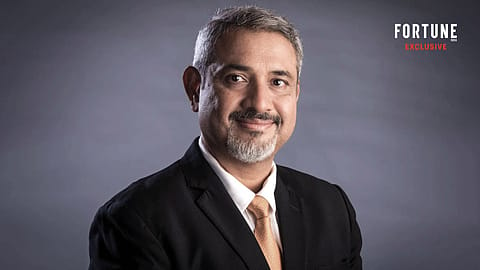India is a market as well as a global capability hub for Lenovo: APAC president Amar Babu
As Lenovo marks two decades in India, Amar Babu, its Asia Pacific president, reflects on its evolution from a PC maker to an AI-driven, full-stack tech company, and why India is central to its next decade.

Lenovo is marking two decades in India with record growth and an aggressive pivot to AI and enterprise solutions. Once seen primarily as a PC maker, the $69 billion tech giant has transformed into a multi-product, solutions-driven company spanning devices, infrastructure, and services. But the real story lies beyond PCs. Almost half of Lenovo’s worldwide revenue now comes from non-PC businesses, including AI-ready servers, data-centre infrastructure, and consulting services. With enterprises racing to adopt AI, Lenovo is positioning itself as a full-stack provider “from pocket to cloud.”
Meanwhile, India has emerged as a key pillar of that transformation, both as a high-growth market and as a global capability hub for research, manufacturing, security, and delivery. Amar Babu, president–Asia Pacific, Lenovo, has been with the company for 18 years and has watched Lenovo’s India journey from the front row. In an interview with Fortune India, he explains how India became an end-to-end growth engine for Lenovo, why AI will define its next decade, and how the company plans to grow responsibly while scaling fast.
Lenovo completes 20 years in India. How has the market evolved over this period? What role does India play in Lenovo’s APAC strategy today?
When I joined Lenovo 18 years ago, it was a single-product PC company with global revenues around $25-27 billion. Fast forward to today, and Lenovo is a $69-billion company, and the India business has grown nearly 10-fold. We’re now a multi-product company with PCs, servers, phones, infrastructure, and services—and nearly 46% of Lenovo’s global revenue comes from outside PCs.
India is a microcosm of Lenovo worldwide. We have R&D for phones and servers, manufacturing, delivery centres, and services here. Our India revenue stood at $3.4 billion in FY25, up 67% year-on-year. We hold an 18.9% share in the Indian PC market, ranking second after HP. More importantly, India contributes not just as a market but as a global capability hub—what we call “Lenovo India for India and Lenovo India for the world.”
Lenovo has positioned itself as a full-stack solutions provider “from pocket to cloud.” How is this strategy driving business growth?
AI is now mainstream, and enterprises everywhere are figuring out how to integrate it. Our “Hybrid AI” vision blends personal AI, enterprise AI, and public cloud AI. Lenovo brings devices, infrastructure, solutions, and services to help customers at every stage of their AI journey.
Recommended Stories
In India, we’ve launched AI PCs and supplied infrastructure for Indic-language AI models such as Ola Krutrim. Globally, we partner with companies like Formula 1 to optimise broadcasting workflows using AI. This full-stack approach, from Motorola smartphones to AI servers and consulting, differentiates us because few companies can offer such breadth.
What is Lenovo doing to ensure AI is deployed responsibly?
Responsible AI is a cornerstone of our strategy. We have a chief AI officer to ensure our AI models use unbiased, inclusive data. We don’t train AI on AI-generated data to avoid perpetuating bias. Sustainability is another focus. Our Neptune liquid-cooling servers cut power consumption by 20-40%, reducing the environmental impact of AI workloads.
Could you tell us more about Lenovo’s AI capability centre in India?
We’re building an AI centre of excellence in India to support global customers. This team works on consulting, roadmaps, and deployment, and will scale to over 1,000 high-skilled employees. Alongside this, we have R&D labs designing servers for worldwide use, plus security and network operations centres managing global enterprise security from India.
Which sectors are seeing the strongest AI adoption in India and APAC?
Software development, supply-chain optimisation, customer service, manufacturing, healthcare diagnostics, and retail theft prevention are early adopters. We’ve deployed AI in supermarkets to detect “skimming,” where people mis-scan items. In Thailand, AI-powered surveillance helps tourism police track pickpockets. These are highly customised, high-impact applications.
Looking ahead, what are Lenovo’s top priorities in India and the region?
We follow a “global-local” model: global R&D and scale combined with local execution. Our priorities for the next two to three years are to grow beyond PCs, using servers, phones, and services as key pillars while embedding AI across everything. Last year, Lenovo grew 21% globally, and we aim to sustain this momentum. AI adoption in Indian enterprises is already high: nearly 50% have pilots or implementations. We see AI as the growth engine for the decade ahead.